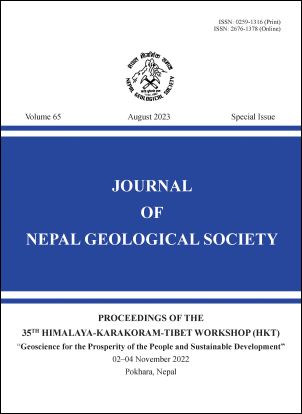Structure and emplacement of leucogranites along the Manaslu - Himalchuli Himalaya, Nepal
DOI:
https://doi.org/10.3126/jngs.v65i01.57738Keywords:
Manaslu Himalaya, leucogranite, emplacement, South Tibetan Detachment, U-Th/Pb monazite datingAbstract
New field mapping data show that the Manaslu leucogranite (Qtz + Plag + Kfs + Ms + Tur ± Bt ± Grt) in Nepal is a composite intrusion derived from a heterogeneous migmatite melt source at depth, and made up of numerous sills parallel to the main foliation, and dipping shallowly to the north. Crustal thickening led to partial melting and formation of leucogranite melts along the top of the GHS, from earlier muscovite dehydration to later biotite dehydration melting with time. The granite was not a diapiric intrusion and does not intrude across the STD low-angle normal fault. A low-angle, north-dipping normal fault, the ductile-brittle Nar-Phu detachment wraps around the top of the Manaslu leucogranite and truncates all leucogranites in the footwall. The detachment formed the roof fault during exhumation of footwall rocks (channel flow) along the upper GHS during the early-middle Miocene. Metamorphism is also entirely regional and not contact metamorphism. U-Th/Pb monazite ages from metapelites show semi-continuous metamorphism across the GHS from ~35-15 Ma. The leucogranites were emplaced as layer-parallel sills entirely within the GHS between ~25-18.5 Ma. U-Th/Pb monazite dates from the Manaslu leucogranites suggest two major intrusion phases at 22.5 Ma (Larke-la phase) and 19.5 Ma (Bimtang phase). The sheeted sill complex was emplaced by progressive underplating with the oldest intrusions structurally above the younger ones. The migmatite melt source was likely buried further to the north. GHS rocks structurally beneath the Manaslu granite show few leucogranite dykes. Heat for granite melting was entirely internally derived radioactive heating from crustal thickening, and had no frictional heat input from the Main Central thrust >10-15 km structurally below the base of the leucogranite sheeted sill complex.
Downloads
Downloads
Published
How to Cite
Issue
Section
License
© Nepal Geological Society




